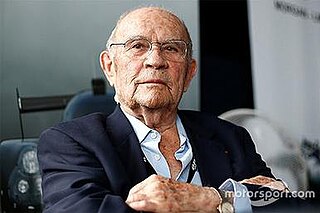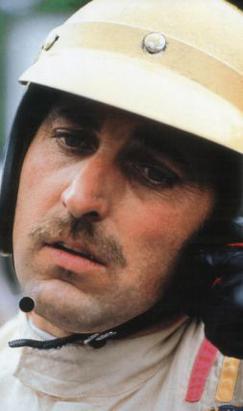
Alain Marie Pascal Prost is a French retired racing driver and Formula One team owner. A four-time Formula One World Drivers' Champion, from 1987 until 2001 he held the record for most Grand Prix victories until Michael Schumacher surpassed Prost's total of 51 victories at the 2001 Belgian Grand Prix.

Renault, a French automobile manufacturer, has been associated with Formula One as both team owner and engine manufacturer for various periods since 1977. In 1977, the company entered Formula One as a constructor, introducing the turbo engine to Formula One with its EF1 engine. In 1983, Renault began supplying engines to other teams. Although the Renault team had won races, it withdrew at the end of 1985. Renault engines continued to be raced until 1986.

The 1982 Caesars Palace Grand Prix was a Formula One motor race held on September 25, 1982 in Las Vegas, Nevada. It was the sixteenth and final race of the 1982 FIA Formula One World Championship, and the second and last F1 race to be held in Caesars Palace.

Jean-Pierre Alain Jabouille was a French racing driver. He raced in 55 Formula One Grands Prix, collecting two wins during the first years of Renault's turbocharged programme in the late 1970s and early 1980s. Jabouille also raced the 24 Hours of Le Mans from the late 1960s to the early 1990s, driving for Alpine, Matra, Sauber, and Peugeot and collecting four 3rd overall finishes in 1973, 1974, 1992, and 1993. Jabouille was one of the last of a breed of Formula One drivers who were also engineers.

Gérard Gilles Marie Armand Larrousse is a former sports car racing, rallying and Formula One driver from France. His greatest success as a driver was winning the 24 Hours of Le Mans in 1973 and 1974, driving a Matra-Simca MS670. After the end of his career as racing car driver, he continued to be involved in Formula One as a team manager for Renault. He later founded and ran his own Formula One team, Larrousse, from 1987 to 1994.

Guy Camille Ligier was a French racing driver and team owner. He maintained many varied and successful careers over the course of his life, including rugby player, butcher, racing driver and Formula One team owner.

Joseph Théodule Marie Schlesser was a French Formula One and sports car racing driver. He participated in three World Championship Grands Prix, including the 1968 French Grand Prix in which he was killed. He scored no championship points. He was the uncle of Jean-Louis Schlesser who himself became a Formula One driver in the 1980s.

André de Cortanze is a French motorsport engineer.
Formula One sponsorship liveries have been used since the 1968 season. Before the arrival of sponsorship liveries in 1968 the nationality of the team determined the colour of a car entered by the team, e.g. cars entered by Italian teams were rosso corsa red, cars entered by French teams were bleu de France blue, and cars entered by British teams were British racing green. Major sponsors such as BP, Shell, and Firestone had pulled out of the sport ahead of this season, prompting the Fédération Internationale de l'Automobile to allow unrestricted sponsorship.

The Honda RA099 was a prototype Formula One racecar, commissioned by Honda, designed by ex-Ferrari and Tyrrell designer Harvey Postlethwaite and built by Dallara in 1999. Its purpose was similar to the one surrounding the Toyota TF101 of 2001, in that it was supposed to be a working test car used in preparation for a full-scale assault on Grand Prix racing in the following years.
Gérard Ducarouge was a French Formula One car designer whose career in motorsport started in 1965 when he joined the French constructor and racing team Equipe Matra Sports. He designed the Matra MS80 car which, entered by the British privateer Matra International team of Ken Tyrrell, won both the World Drivers' Championship and World Constructors' Championship in the 1969 season. After leaving Matra he also designed cars for Ligier and Lotus which won several races in the 1970s and 1980s.

Équipe Ligier is a motorsport team, best known for its Formula One team that operated from 1976 to 1996. The team was founded in 1968 by former French rugby union player Guy Ligier as a sports car manufacturer.

Prost Grand Prix was a Formula One racing team owned and managed by four-time Formula One world champion Alain Prost. The team participated in five seasons from 1997 to 2001.

There have been 74 Formula One drivers from France, the most successful of them being Alain Prost, who won the World Drivers' Championship four times.

The Matra Company's racing team, under the names of Matra Sports, Equipe Matra Elf and Equipe Matra Sports, was formed in 1965 and based at Champagne-sur-Seine (1965–1967), Romorantin-Lanthenay (1967–1969) and Vélizy-Villacoublay (1969–1979). In 1979 the team was taken over by Peugeot and renamed as Automobiles Talbot.

Ligier Automotive, formerly Onroak Automotive, is a French company which designs, manufacturers, and sells racing cars, specifically sports prototypes for various international series. Onroak was founded in 2012 by Jacques Nicolet who split the design, manufacturing, and sales divisions of his OAK Racing team into an independent company. Onroak has since formed an agreement with Philippe Ligier to develop new cars under the Ligier title. On 31 December 2018, it was announced that Onroak Automotive would be rebranded to Ligier Automotive as part of a rebranding and reorganization of Everspeed's automotive assets.

Alpine F1 Team, or currently BWT Alpine F1 Team for sponsorship reasons, is the name under which the Enstone-based Formula One team has been competing since the start of the 2021 Formula One World Championship. Formerly named Renault F1 Team and owned by the French automotive company Groupe Renault as well as Renault–Nissan–Mitsubishi Alliance, the team was rebranded for 2021 to promote Renault's sports car brand, Alpine, and continues to serve as Renault's works team. The chassis and managerial side of the team is based in Enstone, Oxfordshire, England, and the Renault-branded engine side of the team is based in Viry-Châtillon, a suburb of Paris, France. The team competes with a French licence.

The RA series of 3.5-litre and 3.0-litre, naturally-aspirated, V10 racing engines were made by Honda to compete in Formula One racing; between 1989 and 1990, and then again between 2000 and 2005. Between 1992 and 2000, the engines were also made by Mugen Honda. The customer engines were used by McLaren, Arrows, Lotus, Ligier, Tyrrell, Prost, and Jordan.


























